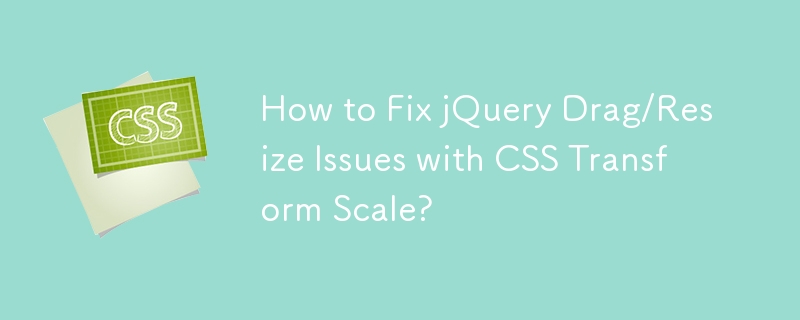How to Fix jQuery Drag/Resize Issues with CSS Transform Scale?
Oct 26, 2024 pm 01:32 PM
jQuery Drag/Resize with CSS Transform Scale
Problem: When applying a CSS transform, specifically transform: matrix(0.5, 0, 0, 0.5, 0, 0);, to a div and using jQuery's draggable() and resizable() plugins on child elements, the alteration made by jQuery becomes "out of sync" with the mouse position.
Solution: Patching jQuery Plugins
A solution was found by patching the jQuery plugins, specifically the _mouseStart and _generatePosition methods of $.ui.draggable. This approach worked effectively but required modifying the original plugin code.
Alternative Solution: Using Callback Handlers
However, a more optimal solution was discovered that does not require modifying the jQuery plugins directly. By utilizing callback handlers, it is possible to adjust the positions and sizes of draggable and resizable elements based on the current zoom scale.
Transform Scale Fix for Resizable:
$(this).resizable({
minWidth: -(contentElem.width()) * 10,
minHeight: -(contentElem.height()) * 10,
resize: function(event, ui) {
// Adjust width and height based on zoom scale
var changeWidth = ui.size.width - ui.originalSize.width;
var newWidth = ui.originalSize.width + changeWidth / zoomScale;
var changeHeight = ui.size.height - ui.originalSize.height;
var newHeight = ui.originalSize.height + changeHeight / zoomScale;
ui.size.width = newWidth;
ui.size.height = newHeight;
}
});
Transform Scale Fix for Draggable:
$(this).draggable({
handle: '.drag-handle',
start: function(event, ui) {
ui.position.left = 0;
ui.position.top = 0;
},
drag: function(event, ui) {
// Adjust left and top positions based on zoom scale
var changeLeft = ui.position.left - ui.originalPosition.left;
var newLeft = ui.originalPosition.left + changeLeft / (( zoomScale));
var changeTop = ui.position.top - ui.originalPosition.top;
var newTop = ui.originalPosition.top + changeTop / zoomScale;
ui.position.left = newLeft;
ui.position.top = newTop;
}
});
This approach provides a clean and non-invasive solution for handling drag and resize events within scaled elements using jQuery without modifying any of its core functionality.
The above is the detailed content of How to Fix jQuery Drag/Resize Issues with CSS Transform Scale?. For more information, please follow other related articles on the PHP Chinese website!

Hot AI Tools

Undress AI Tool
Undress images for free

Undresser.AI Undress
AI-powered app for creating realistic nude photos

AI Clothes Remover
Online AI tool for removing clothes from photos.

Clothoff.io
AI clothes remover

Video Face Swap
Swap faces in any video effortlessly with our completely free AI face swap tool!

Hot Article

Hot Tools

Notepad++7.3.1
Easy-to-use and free code editor

SublimeText3 Chinese version
Chinese version, very easy to use

Zend Studio 13.0.1
Powerful PHP integrated development environment

Dreamweaver CS6
Visual web development tools

SublimeText3 Mac version
God-level code editing software (SublimeText3)

Hot Topics
 What is 'render-blocking CSS'?
Jun 24, 2025 am 12:42 AM
What is 'render-blocking CSS'?
Jun 24, 2025 am 12:42 AM
CSS blocks page rendering because browsers view inline and external CSS as key resources by default, especially with imported stylesheets, header large amounts of inline CSS, and unoptimized media query styles. 1. Extract critical CSS and embed it into HTML; 2. Delay loading non-critical CSS through JavaScript; 3. Use media attributes to optimize loading such as print styles; 4. Compress and merge CSS to reduce requests. It is recommended to use tools to extract key CSS, combine rel="preload" asynchronous loading, and use media delayed loading reasonably to avoid excessive splitting and complex script control.
 External vs. Internal CSS: What's the Best Approach?
Jun 20, 2025 am 12:45 AM
External vs. Internal CSS: What's the Best Approach?
Jun 20, 2025 am 12:45 AM
ThebestapproachforCSSdependsontheproject'sspecificneeds.Forlargerprojects,externalCSSisbetterduetomaintainabilityandreusability;forsmallerprojectsorsingle-pageapplications,internalCSSmightbemoresuitable.It'scrucialtobalanceprojectsize,performanceneed
 Does my CSS must be on lower case?
Jun 19, 2025 am 12:29 AM
Does my CSS must be on lower case?
Jun 19, 2025 am 12:29 AM
No,CSSdoesnothavetobeinlowercase.However,usinglowercaseisrecommendedfor:1)Consistencyandreadability,2)Avoidingerrorsinrelatedtechnologies,3)Potentialperformancebenefits,and4)Improvedcollaborationwithinteams.
 CSS Case Sensitivity: Understanding What Matters
Jun 20, 2025 am 12:09 AM
CSS Case Sensitivity: Understanding What Matters
Jun 20, 2025 am 12:09 AM
CSSismostlycase-insensitive,butURLsandfontfamilynamesarecase-sensitive.1)Propertiesandvalueslikecolor:red;arenotcase-sensitive.2)URLsmustmatchtheserver'scase,e.g.,/images/Logo.png.3)Fontfamilynameslike'OpenSans'mustbeexact.
 What is Autoprefixer and how does it work?
Jul 02, 2025 am 01:15 AM
What is Autoprefixer and how does it work?
Jul 02, 2025 am 01:15 AM
Autoprefixer is a tool that automatically adds vendor prefixes to CSS attributes based on the target browser scope. 1. It solves the problem of manually maintaining prefixes with errors; 2. Work through the PostCSS plug-in form, parse CSS, analyze attributes that need to be prefixed, and generate code according to configuration; 3. The usage steps include installing plug-ins, setting browserslist, and enabling them in the build process; 4. Notes include not manually adding prefixes, keeping configuration updates, prefixes not all attributes, and it is recommended to use them with the preprocessor.
 What are CSS counters?
Jun 19, 2025 am 12:34 AM
What are CSS counters?
Jun 19, 2025 am 12:34 AM
CSScounterscanautomaticallynumbersectionsandlists.1)Usecounter-resettoinitialize,counter-incrementtoincrease,andcounter()orcounters()todisplayvalues.2)CombinewithJavaScriptfordynamiccontenttoensureaccurateupdates.
 CSS: When Does Case Matter (and When Doesn't)?
Jun 19, 2025 am 12:27 AM
CSS: When Does Case Matter (and When Doesn't)?
Jun 19, 2025 am 12:27 AM
In CSS, selector and attribute names are case-sensitive, while values, named colors, URLs, and custom attributes are case-sensitive. 1. The selector and attribute names are case-insensitive, such as background-color and background-Color are the same. 2. The hexadecimal color in the value is case-sensitive, but the named color is case-sensitive, such as red and Red is invalid. 3. URLs are case sensitive and may cause file loading problems. 4. Custom properties (variables) are case sensitive, and you need to pay attention to the consistency of case when using them.
 Case Sensitivity in CSS: Selectors, Properties, and Values Explained
Jun 19, 2025 am 12:38 AM
Case Sensitivity in CSS: Selectors, Properties, and Values Explained
Jun 19, 2025 am 12:38 AM
CSSselectorsandpropertynamesarecase-insensitive,whilevaluescanbecase-sensitivedependingoncontext.1)Selectorslike'div'and'DIV'areequivalent.2)Propertiessuchas'background-color'and'BACKGROUND-COLOR'aretreatedthesame.3)Valueslikecolornamesarecase-insens






